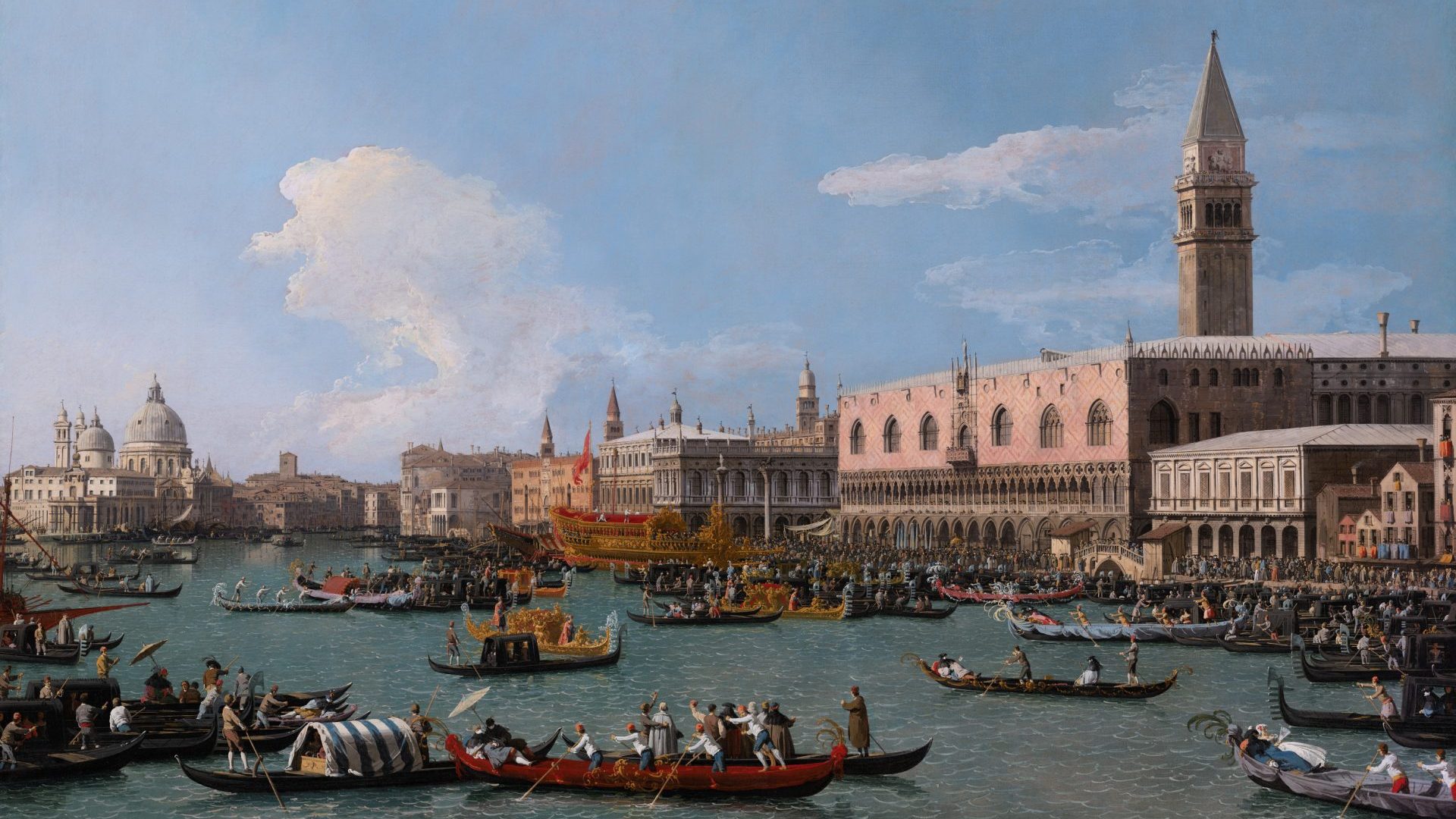Venice is “a glorious City in the Sea”, wrote the 18th-century poet Samuel Rogers. Percy Bysshe Shelley enthused: “Its temples and palaces did seem like fabrics of enchantment piled to heaven,” while more than 100 years later the gallerist Peggy Guggenheim wrote: “Venice is not only a city of fantasy and freedom. It is also a city of joy and pleasure.”
Indeed, there has scarcely been a poet, writer or art lover who has not rhapsodised about La Serenissima.
But what to make of: “Venice is doomed to be too beautiful.” That’s the less than rhapsodic challenge presented by Venetian activist Giacomo-Maria Salerno, an expert on the dangers of untrammelled tourism.
The answer, at the very least, is a pause for thought – especially as the challenging statement is made on video after visitors have just filed past a ravishing series of paintings in the exhibition Canaletto’s Venice Revisited at the National Maritime Museum in Greenwich.
In a telling epilogue to the show we are presented with the fear that Venice is doomed to sink into the lagoon like the lost city of Atlantis after decades of
environmental neglect. Or will it muddle on in gaudy dissonance as a Disneyland for the millions of tourists who swarm off the cruise ships? These are questions to which the solutions have been slow in coming.
But first, the show – and what a joy it is. No one captured the glory of Venice
with greater charm or a more acute eye than Giovanni Antonio Canal (1697-1768), aka Canaletto.
So familiar are the scenes that they have become almost a cliche; the Grand Canal lined with palazzi, the water abuzz with boats, the fabulous onion domes of St Mark’s Basilica, the Gothic grandeur of the Doge’s Palace, the men doing business in the squares, the light from blue, open skies with just a few curls of cloud casting light and shade on to the red, ochre and yellow of the buildings.
On the face of it, much of Venice has remained unchanged since the artist set up his easel 300 or so years ago. The sights he painted he would recognise today – the towers that “survey the lagoon in crotchety splendour”, as Jan Morris described her first impressions in the book Venice, “the tottering palaces, brooding and monstrous… a gnarled but gorgeous city”.
It’s all there with Canaletto.
Look north along the Grand Canal to the Palazzo Contarini dagli Scrigni and the Palazzo Rezzonico, with its radiant displays of Tiepolo ceilings, further along, the filigreed balconies of Ca D’Oro and, on the other bank, the Baroque marble Palazzo Pesaro, now home to a collection of 19th and 20th
century paintings. Look back to the bulk of Il Redentore, the domes of Santa
Maria della Salute, both built in thanks for the city being spared the plague.
More than the buildings, what gives the paintings such vibrancy are the people, portrayed in startling detail, right down to the individual colour of a
jerkin, the cut of a tunic, the style of the dresses. In each sweep of a vista, small individual moments take the eye.
In View of the Grand Canal from the Palazzo Bembo to Palazzo Vendramin-Calergi, two brightly dressed young women bring some vivacity to a scene in which the other boats seem intent on business. One of the rowers sports a red hat, the other a dashing white shirt and blue cummerbund.
In another canal scene, the boatman strains as two women are rowed across the calm waters in his traghetto. One is in black, the other in white. They could be mother and daughter.
Amid all the hustle and bustle of View of the Doge’s Palace at the Piazzetta seen from the Bacino an angry boatman is pushing away a boat that is bearing down on him with its prow threatening to take out his eye. He is in danger of toppling into the water, but his friends ignore him. While men discuss deep matters in the square by San Rocco, two boys are playing on the church steps and the turbaned figure in the crowds of the Piazza San Marco could be a merchant trading in spices, a reminder that Venice was at the centre of trade between the Middle East and Europe.
And there are dogs, always dogs, in every square, scratching themselves, sniffing, fighting.
Canaletto brings drama to the great occasions of his day – events that are still held today. In the riot and colour of Ascension Day: The embarkation of the Doge of Venice for the Ceremony of the Marriage of the Adriatic, which celebrated Venice’s pre-eminence as a naval power, the gold of the state barge is almost lost in the turmoil of small boats and eager sightseers.
Again, it is the detail, the colour, the sheer scope of his vision. In A Regatta
on the Grand Canal everything thrums with activity. Women join the crowds
on the quayside in their best gowns to watch the races while in contrast to the hubbub another woman in white with a dainty hat sits placidly on a boat
as gesticulating men cheer on their favourites. Spectators hang from balconies decorated with gaudy hangings and flowers, they even pop up on rooftops for a better view.
And then there are the racers, heaving and puffing, muscles straining, as they struggle to win the race.
Mark Twain told it best in The Innocents Abroad: “The gondolier is a picturesque rascal for all he wears no satin harness, no plumed bonnet, no
silken tights. His attitude is stately; he is lithe and supple; all his movements
are full of grace. When his long canoe, and his fine figure, towering from its
high perch on the stern, are cut against the evening sky, they make a picture that is very novel and striking to a foreign eye.”
So much remains of Canaletto’s day – not least the gondoliers – but there are examples of change. His depiction of the Arsenale, once the centre for the shipbuilding that gave Venice its power, is a reminder that today those skills have all but died out.
The view of the Church of Santa Lucia is no more because it was pulled down in 1860 and replaced by the station and the bridge that connected it to the mainland. In Death in Venice Thomas Mann wrote: “Arriving by train was like entering a palace by the back door.” Fortunately for his sensibilities he was spared the modernist facade built in 1952.
All these images would have been in demand with the tourists who flocked to the city and Canaletto was only too happy to oblige what were, in effect, the postcards and souvenirs of the day.
One of those travellers was Lord John Russell of Woburn Abbey, a cricket-loving Whig diplomat who bought 24 paintings from Canaletto and hung them on the walls of Woburn Abbey, his home in Bedfordshire, which, as a reflection for his admiration of all things Venetian, is designed in the Palladian style of Il Redentore. It is this collection that is on show at the Maritime Museum.
Maybe Lord Russell had come across Canaletto when the artist visited London in 1746. The exhibition has a small note confirming the first instalment of a purchase by him for a painting worth £27 1s 8d (about £5,000
today) but we know little about the artist. A small sketch of him by Antonio Visentini reveals a knowing, sharp-eyed character with the sideways look of a man negotiating another profitable sale.
Today, the tourists who spill off the cruise ships with a checklist of sights might buy the modern equivalents – postcards, Murano glass chandeliers and brass lions – or more likely take selfies outside one of the many branches of McDonald’s.
The threat of the cruise ships is highlighted in the coda to the exhibition. Until recently ships carrying almost 3,000 people and weighing well over 100,000 tonnes would sail precariously along the narrow canal that separated the Giudecca from the rest of Venice. Now, at last, after Unesco threatened to place the city on its endangered list unless the ships were banned, no ships of more than 25,000 tonnes are permitted to dock in the city.
As tourism has grown, the population of the city has fallen from about 129,000 in 1871 to a mere 50,510 in 2021 and as rents rise and more properties are sold to outsiders it is liable to become little more than an elegant holiday camp.
But that threat to the integrity of the place is overwhelmed by the threat from climate change. Although a flood barrier that opened in October 2020
should help to ease the problem of flooding, an interactive screen spells out the peril in graphic terms. The first flood above 140cm was recorded in 1936. In 2020 alone there were 13 floods higher than 140cm.
The old joke by the humorist Robert Benchley when he arrived in the city for the first time – “Streets flooded. Please advise” – is no longer amusing. On one day in November 2020, the water was so deep that tourists actually swam in St Mark’s Square.
As the writer Henry James, who lived in the city for many years at the end of the 19th century, remarked: “Though there are some disagreeable things in Venice, there is nothing so disagreeable as the visitors.”
Canaletto’s Venice Revisited, National Maritime Museum, Greenwich, until September 25
Richard Holledge writes about the visual arts for the Wall Street Journal, Gulf News, FT and The New European




